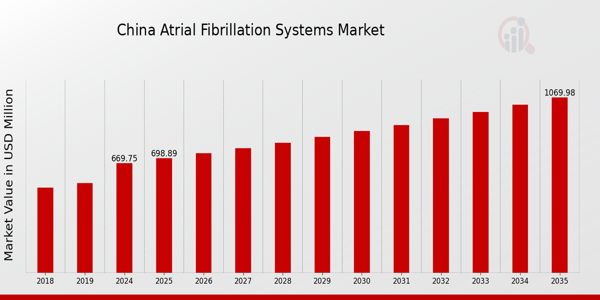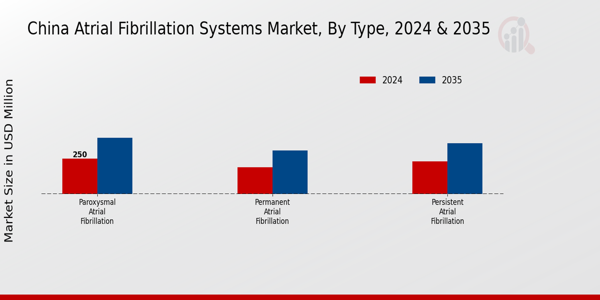China Atrial Fibrillation Systems Market Overview
As per MRFR analysis, the China Atrial Fibrillation Systems Market Size was estimated at 639.75 (USD Million) in 2023.The China Atrial Fibrillation Systems Market Industry is expected to grow from 669.75(USD Million) in 2024 to 1,070 (USD Million) by 2035. The China Atrial Fibrillation Systems Market CAGR (growth rate) is expected to be around 4.351% during the forecast period (2025 - 2035).
Key China Atrial Fibrillation Systems Market Trends Highlighted
Driven by the rising incidence of atrial fibrillation (AF), mostly due to the aging population and urban lifestyle changes, the China Atrial Fibrillation Systems Market is growing notably. Prioritizing cardiovascular health, the Chinese government has increased awareness and screening initiatives, hence fostering early diagnosis and treatment acceptance. Advancements in medical technology are driving more need for creative goods and solutions in AF treatment, like catheter ablation, implanted devices, and remote monitoring systems. Important possibilities exist in the creation of reasonably priced solutions catered to fit the requirements of the Chinese healthcare system.
The growth of telemedicine and digital health technologies offers an opportunity to enhance patient access and monitoring, particularly in rural and underprivileged regions. Furthermore, given the government's drive for changes in healthcare, collaborations between medical device makers and healthcare organizations can improve service delivery. Reflecting a more general worldwide push towards value-based care, recent developments show a shift towards personalized medicine and least invasive treatments. Both public and private sector rising research and development funding seeks to improve treatment accuracy and effectiveness.
Notable as well has been the development of disposable catheter technology, which helps to simplify treatments and reduce the danger of infection, which is especially important in Chinese healthcare environments. Emphasizing patient outcomes, supported by encouraging legislation and healthcare infrastructure investments, helps the atrial fibrillation systems industry to flourish.

Source: Primary Research, Secondary Research, Market Research Future Database and Analyst Review
China Atrial Fibrillation Systems Market Drivers
Rising Prevalence of Atrial Fibrillation in China
The increasing prevalence of atrial fibrillation (AF) in China is a significant driver of growth in the China Atrial Fibrillation Systems Market Industry. Current estimates indicate that about 9 million people in China are living with AF, a number that has shown a steady rise as more individuals are diagnosed due to improved awareness and advancements in diagnostic techniques.
According to the National Health Commission of China, cardiovascular diseases remain a leading cause of death, affecting millions and referring to a notable increase in AF cases particularly among the elderly.This demographic shift is vital as the proportion of the population aged 65 and older is projected to reach 35% by 2050, substantially increasing the demand for effective atrial fibrillation systems to manage this chronic condition.
The expanding market for atrial fibrillation systems will benefit from the support of organizations such as the China Cardiovascular Society, which promotes awareness, prevention, and treatment of heart diseases, ensuring that healthcare providers are equipped and informed about the latest technologies.
Technological Advancements in Atrial Fibrillation Treatment
Ongoing advancements in medical technology significantly bolster the China Atrial Fibrillation Systems Market Industry. Innovations such as catheter ablation technologies, wearable heart monitoring devices, and implantable cardioverter-defibrillators are transforming the treatment landscape for AF in China. For instance, recent reports from the Ministry of Industry and Information Technology of China indicate that investments in medical technology R&D have increased by 20% annually over the last five years, highlighting a robust environment for healthcare innovation.Companies like Beijing Pangu Technology have made strides in developing minimally invasive techniques that enhance patient outcomes.
The government has also prioritized healthcare technology improvements through the Healthy China initiative, allocating substantial resources to advance cardiac care, thereby further driving the market.
Government Initiatives and Policy Support
The Chinese government is taking substantial steps to improve the healthcare system, including policies specifically targeting the management of atrial fibrillation. The State Council of China has launched various health promotion initiatives and investment plans aimed at cardiovascular health, which are vital for the growth of the China Atrial Fibrillation Systems Market Industry. The government has increased funding for public health programs that focus on the prevention and management of chronic diseases, including atrial fibrillation.For instance, the establishment of the Cardiovascular Disease Prevention and Control System is a strategic response to the rising morbidity rates associated with heart diseases.
This increased emphasis on cardiovascular health is supported by the National Health Commission's 2030 goals, which signal a commitment to integrating advanced medical technologies into everyday healthcare. Such policies provide an advantageous landscape for market players and encourage international collaboration to introduce innovative atrial fibrillation solutions in China.
China Atrial Fibrillation Systems Market Segment Insights
Atrial Fibrillation Systems Market Type Insights
The China Atrial Fibrillation Systems Market is a vital segment of the healthcare industry, specifically addressing the needs of patients suffering from different forms of atrial fibrillation. The market can be categorized into three important types: Paroxysmal Atrial Fibrillation, Persistent Atrial Fibrillation, and Permanent Atrial Fibrillation. Among these, Paroxysmal Atrial Fibrillation is characterized by intermittent episodes that may spontaneously self-terminate, which often leaves patients in a state of unpredictability regarding their health.
This type presents unique challenges in monitoring and treatment, thereby driving innovations within the market, particularly in the area of wearables and implantable devices designed to manage episodes more effectively.
Conversely, Persistent Atrial Fibrillation signifies a more prolonged condition requiring more intensive management strategies and often leads to higher healthcare costs due to its increasing complexity. This type tends to drive demand for advanced therapeutic technologies and intervention procedures, as patients often require hospitalization and more specialized care to restore normal heart rhythm. The need for patient education and healthcare professional training is significant in this segment, highlighting the importance of collaboration within the healthcare ecosystem. Lastly, Permanent Atrial Fibrillation is a chronic condition that represents a significant portion of the atrial fibrillation population in China.
This type necessitates a long-term approach to treatment that focuses on lifestyle modifications and ongoing management rather than attempts to restore normal rhythm.
The increasing prevalence of lifestyle-related conditions such as hypertension and obesity in China has amplified the significance of this segment, leading to demand for tailored healthcare solutions and comprehensive programs targeting the underlying factors contributing to atrial fibrillation. Overall, the classification into these types illustrates the varying complexities and treatment approaches within the China Atrial Fibrillation Systems Market, making it evident that each form necessitates specific therapeutic solutions and poses distinct challenges for healthcare providers.
The growth in health infrastructure and advancements in medical technology across China further support the development of this market segment, as stakeholders increasingly recognize the necessity of addressing the nuanced needs of patients suffering from atrial fibrillation. This, in turn, opens doors for innovative treatment options aimed at improving patient outcomes and healthcare efficiency, aligning with the growing demand for effective atrial fibrillation management in the region.

Source: Primary Research, Secondary Research, Market Research Future Database and Analyst Review
Atrial Fibrillation Systems Market Treatment Approach Insights
The Treatment Approach segment of the China Atrial Fibrillation Systems Market plays a crucial role in managing atrial fibrillation, reflecting diverse methodologies tailored to patient needs. Drug therapy remains a fundamental approach, utilized for rate control and rhythm management, contributing significantly to overall treatment efficacy. Cardioversion, both electrically and pharmacologically, serves as an essential method for restoring normal heart rhythm, particularly in acute settings.
Catheter ablation has gained traction as a minimally invasive option, often preferred for its potential to offer long-term solutions for selected patient groups.Surgical procedures, while less common, address complex cases and are vital in providing definitive treatment pathways. This segmentation highlights the evolving dynamics of the China Atrial Fibrillation Systems Market, driven by advancements in technology and an increasing pool of patients necessitating tailored treatment options.
The growing prevalence of atrial fibrillation in China, influenced by aging demographics and lifestyle factors, further underscores the importance of effective treatment strategies in improving patient outcomes and quality of life within the healthcare landscape.
Atrial Fibrillation Systems Market End User Insights
The End User segment of the China Atrial Fibrillation Systems Market plays a crucial role in shaping the overall dynamics of the industry. Hospitals are often the primary users of atrial fibrillation systems due to their capacity to handle complex cases and their advanced technological resources. This segment not only provides critical care but also contributes significantly to the research and training of medical professionals in this field. Ambulatory Surgical Centers are gaining prominence as they offer a more efficient and less invasive option for patients, thus driving demand for these systems as procedures become more outpatient-oriented.
Furthermore, Cardiology Clinics focus on specialized care, giving patients a dedicated environment for diagnosis and treatment, which makes this segment increasingly essential in managing atrial fibrillation. Rising incidences of cardiovascular diseases in China further emphasize the need for these facilities to be equipped with state-of-the-art atrial fibrillation systems, catering to the specific needs of patients, thereby reflecting positive growth trends in the market. The combination of these factors highlights the significant impact each End User segment has on the overall landscape of the China Atrial Fibrillation Systems Market.
China Atrial Fibrillation Systems Market Key Players and Competitive Insights
The China Atrial Fibrillation Systems Market has seen considerable growth in recent years, driven by increasing awareness of atrial fibrillation (AF), advancements in medical technology, and a push towards improved patient outcomes. Atrial fibrillation is a common cardiac arrhythmia that poses significant health risks, making effective management essential. The competitive landscape is characterized by a variety of players, ranging from established medical device manufacturers to emerging companies specializing in innovative treatment solutions.
Companies operating in this market focus on a mix of product offerings, including diagnostic devices, treatment options, and integrated systems aimed at addressing the unique demands presented by AF patients in China. As the market adapts to regulatory changes and heightened competition, companies are continuously seeking strategies to enhance their market share and relevance in addressing the challenges posed by this condition.
Siemens Healthineers holds a prominent position in the China Atrial Fibrillation Systems Market, bolstered by its impressive portfolio of diagnostic imaging and treatment technologies. The company's innovative approaches, such as advanced imaging solutions that facilitate precise AF diagnosis, empower healthcare professionals to make informed decisions regarding patient management. Siemens Healthineers' strong presence in China is underscored by its extensive distribution network and commitment to research and development, enabling the firm to remain at the forefront of technological advancements in the sector.
Their focus on quality and reliability fosters trust among healthcare providers, allowing Siemens Healthineers to maintain a competitive edge in a rapidly evolving market. The company's strategic partnerships and collaborations further enhance its market standing, as it continuously integrates novel technologies that streamline the treatment workflow for atrial fibrillation.
St. Jude Medical has established itself as a key player in the China Atrial Fibrillation Systems Market through its comprehensive range of cardiac devices and therapies tailored for AF management. With a strong emphasis on innovation, St. Jude Medical offers an array of products, including ablation catheters and remote monitoring systems that cater specifically to the needs of patients in China. The company's commitment to enhancing patient care is reflected in its robust research efforts and partnerships, which have enabled it to adapt its offerings to local market requirements. St.
Jude Medical's strengths lie in its trusted reputation among healthcare providers, effective patient engagement strategies, and tailored educational initiatives aimed at raising awareness about AF prevention and management. Furthermore, St. Jude Medical has actively pursued mergers and acquisitions to broaden its product portfolio and strengthen its market position, allowing it to leverage synergies and technological advancements to enhance its offering in the competitive landscape of atrial fibrillation in China.
Key Companies in the China Atrial Fibrillation Systems Market Include
- Regeneron Pharmaceuticals
China Atrial Fibrillation Systems Market Industry Developments
China's Atrial Fibrillation Systems Market has seen notable developments recently, particularly with major companies like Siemens Healthineers, St. Jude Medical, and Medtronic advancing their product offerings and market presence. In January 2023, Medtronic launched an extensive suite of AFib solutions tailored for the Chinese healthcare system, responding to the nation's growing needs for heart rhythm management.
Additionally, in September 2023, Boston Scientific acquired certain assets of iRhythm Technologies, enabling strengthened collaboration within the Chinese market for digital heart monitoring solutions.The growth trajectory for the Atrial Fibrillation Systems Market is underscored by a significant rise in market valuation due to increasing incidences of atrial fibrillation in China, which is projected to double by 2030 according to the Chinese National Center for Cardiovascular Diseases.
Companies like Abbott and Philips Healthcare are also expanding their reach, introducing innovative technologies to enhance patient care. Furthermore, in recent years, strong regulatory support and funding initiatives from the Chinese government have bolstered the overall infrastructure for medical technology, facilitating advancements in research and development for these life-saving systems. The focus on improving healthcare quality in China continues to drive market evolution.
China Atrial Fibrillation Systems Market Segmentation Insights
Atrial Fibrillation Systems Market Type Outlook
- Paroxysmal Atrial Fibrillation
- Persistent Atrial Fibrillation
- Permanent Atrial Fibrillation
Atrial Fibrillation Systems Market Treatment Approach Outlook
Atrial Fibrillation Systems Market End User Outlook
- Ambulatory Surgical Centers
| Report Attribute/Metric Source: |
Details |
| MARKET SIZE 2018 |
639.75(USD Million) |
| MARKET SIZE 2024 |
669.75(USD Million) |
| MARKET SIZE 2035 |
1070.0(USD Million) |
| COMPOUND ANNUAL GROWTH RATE (CAGR) |
4.351% (2025 - 2035) |
| REPORT COVERAGE |
Revenue Forecast, Competitive Landscape, Growth Factors, and Trends |
| BASE YEAR |
2024 |
| MARKET FORECAST PERIOD |
2025 - 2035 |
| HISTORICAL DATA |
2019 - 2024 |
| MARKET FORECAST UNITS |
USD Million |
| KEY COMPANIES PROFILED |
Siemens Healthineers, St. Jude Medical, MicroPort, LivaNova, Cardiac Science, Biosense Webster, Regeneron Pharmaceuticals, Medtronic, Boston Scientific, AtriCure, Philips Healthcare, iRhythm Technologies, Comba Telecom, Johnson & Johnson, Abbott |
| SEGMENTS COVERED |
Type, Treatment Approach, End User |
| KEY MARKET OPPORTUNITIES |
Rising prevalence of atrial fibrillation, Increased government healthcare spending, Advancements in ablation technologies, Growing awareness and education, Expansion of telehealth solutions |
| KEY MARKET DYNAMICS |
increasing prevalence of atrial fibrillation, growing aging population, advancements in catheter technology, rising demand for minimally invasive procedures, supportive government initiatives |
| COUNTRIES COVERED |
China |
Frequently Asked Questions (FAQ):
The China Atrial Fibrillation Systems Market is expected to be valued at 669.75 million USD in 2024.
By 2035, the market is projected to reach a value of 1070.0 million USD.
The expected CAGR for the China Atrial Fibrillation Systems Market from 2025 to 2035 is 4.351%.
The Paroxysmal Atrial Fibrillation segment is anticipated to hold the largest market share, valued at 250.0 million USD in 2024.
The market value for Persistent Atrial Fibrillation is expected to reach 360.0 million USD by 2035.
Major players in the market include Siemens Healthineers, St. Jude Medical, Medtronic, and Boston Scientific.
Challenges could include regulatory hurdles and increased competition among emerging technologies.
Growing healthcare investments and advancements in medical technology present significant growth opportunities.
The market value for Permanent Atrial Fibrillation is projected to be 189.75 million USD in 2024.
Demand in urban areas is driving market growth, as healthcare infrastructure and awareness are rapidly improving.
















